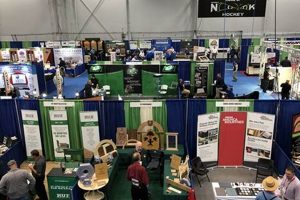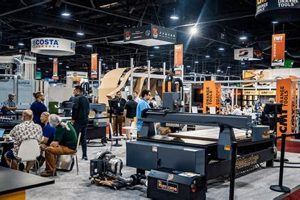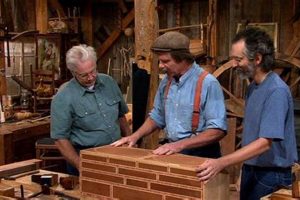A televised program centered on the craft of shaping wood, its techniques, and related projects constitutes a specific genre of broadcast content. These productions often showcase skilled artisans demonstrating various woodworking methods, tool usage, and project completion. For example, a series might feature the construction of furniture, cabinetry, or decorative wooden objects, providing step-by-step instruction and visual demonstrations.
Such programming offers several key benefits. It serves as an educational resource, allowing viewers to learn new skills and techniques from experienced practitioners. Furthermore, it can inspire creativity and encourage individuals to pursue woodworking as a hobby or profession. Historically, these programs have contributed to the preservation and promotion of traditional woodworking skills, ensuring their continuation across generations. They also provide entertainment value, showcasing the beauty and artistry inherent in the manipulation of wood.
The following sections will delve into specific aspects of this programming genre, including its target audience, common formats, notable examples, and the impact it has on the woodworking community.
Tips from Woodworking-Focused Television Programs
Educational broadcasts dedicated to woodworking offer a wealth of practical advice and techniques. Observing and applying the following tips, often demonstrated on these programs, can significantly improve woodworking skills and project outcomes.
Tip 1: Prioritize Safety. Before commencing any woodworking task, ensure the appropriate safety gear is worn, including eye protection, hearing protection, and respiratory masks. Familiarize oneself with the safety guidelines specific to each tool being used. Programs frequently emphasize safety protocols as an essential first step.
Tip 2: Master Tool Maintenance. Regularly sharpen chisels, plane irons, and saw blades. Dull tools are not only inefficient but also more dangerous. Woodworking demonstrations consistently showcase the importance of sharp tools and the techniques for maintaining them.
Tip 3: Practice Proper Wood Selection. Understand the properties of different wood species. Consider factors such as hardness, grain, and moisture content when selecting wood for a specific project. Television shows dedicated to this craft often dedicate segments to wood species and their applications.
Tip 4: Perfect Jointing Techniques. Accurate joinery is critical for structural integrity and aesthetic appeal. Learn and practice various jointing methods, such as dovetails, mortise and tenon, and rabbets. Many shows provide detailed instructions and demonstrations of these techniques.
Tip 5: Apply Finishes Correctly. Proper finishing enhances the beauty and protects the wood. Learn about different types of finishes, such as varnish, lacquer, and oil, and their application techniques. Many shows demonstrate finish application and troubleshooting common issues.
Tip 6: Use Accurate Measurement and Layout: Before cutting, double check measurement to minimize error, it’s the basis of any successful woodworking. Many show dedicated about woodworking always use and show accurate measurement.
Tip 7: Utilize Dust Collection Systems. Woodworking generates significant dust, which poses health hazards. Employ effective dust collection systems to minimize exposure. Programs often highlight the use of dust collectors and respirators to promote a safe working environment.
By adhering to these tips, derived from experienced woodworkers and frequently highlighted on television broadcasts focused on the craft, individuals can improve their skills, enhance the quality of their projects, and ensure a safer and more enjoyable woodworking experience.
Applying the tips above, woodworking can be an enjoyable hobby and can yield impressive results with constant practice.
1. Skills Demonstration
The element of “Skills Demonstration” is fundamental to the appeal and educational value of woodworking programs broadcast on television. These programs often feature experts exhibiting specific techniques, methodologies, and best practices, serving as a visual learning resource for aspiring or experienced woodworkers.
- Joinery Techniques
The meticulous construction of joints, such as dovetails, mortise and tenons, or rabbets, is frequently demonstrated. Programs may showcase various approaches, from hand-tool methods to power-tool applications. The demonstration includes the preparation of materials, precise cutting techniques, and assembly procedures, highlighting the importance of accuracy and proper tool usage.
- Wood Finishing
Application of stains, sealants, and topcoats is often featured to achieve desired aesthetics and protect wood surfaces. Demonstrations cover surface preparation, application methods, and drying or curing techniques. Programs may explore different types of finishes, their properties, and their suitability for specific projects.
- Tool Usage and Maintenance
The proper and safe operation of woodworking tools, both hand-powered and machine-driven, is commonly demonstrated. Programs often provide guidance on tool selection, setup, and maintenance to ensure optimal performance and longevity. Emphasis is placed on safety protocols and best practices to prevent accidents.
- Project-Specific Techniques
Specific skills related to individual woodworking projects, such as furniture construction, cabinetmaking, or carving, are demonstrated. These segments provide viewers with step-by-step instructions and visual aids to replicate the project at home. Emphasis is placed on planning, material selection, and execution techniques unique to each project.
The inclusion of Skills Demonstration within this broadcasting genre provides viewers with a readily accessible and engaging educational platform. By showcasing practical techniques and expert knowledge, these programs foster a greater appreciation for woodworking and empower individuals to develop their own skills and pursue creative projects.
2. Project-Based Learning
Project-Based Learning, when integrated into televised woodworking programming, transforms passive viewing into an active educational experience. The medium provides a structured approach to acquiring woodworking skills through the completion of tangible projects, enhancing comprehension and retention.
- Step-by-Step Guidance
Programs offer meticulous, sequential instructions for completing woodworking projects. This format enables viewers to follow along and replicate the projects themselves, reinforcing learned concepts through practical application. For instance, a show might detail the construction of a bookcase, breaking down each step from material selection to finishing. This approach translates theoretical knowledge into demonstrable skill.
- Real-World Application
The projects featured in these shows simulate real-world scenarios, presenting viewers with challenges and problem-solving opportunities. Constructing a dovetail joint, for example, requires precise measurements and skillful execution. Successfully completing such a task provides a sense of accomplishment and reinforces the importance of accuracy and attention to detail. These applications contribute to a more profound understanding of woodworking principles.
- Skill Reinforcement
Project-Based Learning facilitates the reinforcement of previously learned skills. Each new project builds upon existing knowledge, progressively increasing the viewer’s proficiency. A project involving cabinet construction, for instance, might require the application of skills learned in previous episodes, such as cutting joinery, assembling components, and applying finishes. This iterative process enhances long-term retention and mastery.
- Tangible Outcomes
The completion of a woodworking project provides a tangible outcome that serves as a source of motivation and reinforcement. Having a physical product, such as a table or a chair, that the viewer has personally constructed fosters a sense of accomplishment and encourages further exploration of woodworking. The visible results of their efforts provide concrete evidence of their progress and skill development.
In essence, integrating Project-Based Learning into the medium of woodworking shows converts the viewing experience into an apprenticeship. The methodical breakdown of projects, coupled with real-world applications and tangible results, creates an optimal environment for skill acquisition and long-term retention.
3. Tool Expertise
Woodworking programs on television rely heavily on demonstrations of tool expertise, acting as a conduit for disseminating knowledge of woodworking tools, their applications, and their maintenance. The presence of tool expertise within these broadcasts functions as both a cause and an effect. It is a cause because proficient tool handling is instrumental in achieving quality results. The demonstrator’s adeptness directly influences the outcome of projects showcased on the program. Conversely, it is an effect because the programs themselves generate demand for particular tools, influencing purchasing decisions and shaping the market for woodworking implements. For example, a show featuring advanced joinery techniques may highlight a specific type of dovetail jig, leading viewers to seek out and purchase that particular tool.
The importance of tool expertise within this programming genre is multi-faceted. First, it ensures the safety of the viewers who may attempt to replicate the projects demonstrated. Safe tool handling is repeatedly emphasized, reducing the risk of accidents. Second, accurate tool usage is crucial for achieving precision and quality in woodworking. The demonstrator’s ability to properly set up and utilize tools directly impacts the final product. Third, knowledge of tool maintenance, such as sharpening blades and calibrating machines, extends the lifespan of tools and ensures consistent performance. Shows often incorporate segments dedicated to tool maintenance, educating viewers on best practices. For instance, a series might dedicate an entire segment to sharpening plane irons or calibrating a table saw.
In summary, tool expertise is a fundamental component of woodworking programs on television, shaping viewer understanding, purchasing behaviors, and project outcomes. The effective transmission of this expertise, encompassing safe practices, precise tool usage, and proactive maintenance, is key to the educational value and practical application of these shows. Challenges remain in ensuring that the viewers adequately grasp the nuances of tool usage from a distance and in providing sufficient context for diverse skill levels, but the significance of tool expertise within the genre remains paramount.
4. Design Inspiration
The realm of design inspiration constitutes a core element within the landscape of television programming dedicated to woodworking. These programs frequently serve as a catalyst for innovative approaches and stylistic choices in woodworking projects, influencing viewers’ aesthetic preferences and creative endeavors.
- Showcasing Diverse Styles
Programming often presents a spectrum of design styles, ranging from traditional to contemporary. This exposure allows viewers to discern their personal preferences and adapt elements from various styles into their own projects. Examples include programs featuring Shaker furniture, mid-century modern designs, or intricate marquetry work. The integration of diverse styles broadens viewers’ understanding of design possibilities.
- Adapting Historical Designs
Many broadcasts explore historical woodworking designs, providing viewers with a foundation in classic forms and construction techniques. By examining the design principles of past eras, viewers can gain a deeper appreciation for the evolution of woodworking and incorporate historical elements into their contemporary creations. Shows may feature reproductions of antique furniture or discussions on the design philosophy of renowned woodworkers.
- Introducing Novel Techniques
Design inspiration extends beyond aesthetics to encompass innovative techniques and materials. Programs frequently demonstrate the use of unconventional materials, such as reclaimed wood or epoxy resin, as well as cutting-edge joinery methods. This exposure encourages viewers to experiment with new approaches and push the boundaries of traditional woodworking.
- Problem-Solving and Functionality
Effective design addresses both aesthetic and functional requirements. Woodworking programs often feature projects that solve specific design challenges, such as maximizing storage space in a small apartment or creating ergonomic furniture. By observing how designers overcome these challenges, viewers can develop their own problem-solving skills and create functional and aesthetically pleasing pieces.
These aspects of design inspiration, as conveyed through television shows dedicated to woodworking, collectively contribute to a more informed and creatively stimulated audience. The programs function as visual repositories of design ideas, fostering an appreciation for craftsmanship and encouraging viewers to engage in their own woodworking pursuits with a refined sense of aesthetics and functionality.
5. Safety Emphasis
The integration of safety protocols within televised woodworking programming is paramount, functioning not merely as a precautionary measure, but as a fundamental component of responsible instruction and demonstration. The emphasis on safety is critical given the inherent risks associated with power tools, sharp instruments, and airborne particulate matter commonly encountered in woodworking environments.
- Personal Protective Equipment (PPE) Demonstration
Programs routinely showcase and emphasize the use of appropriate PPE, including but not limited to: safety glasses or face shields to protect against projectiles; hearing protection to mitigate noise-induced hearing loss; and respirators or dust masks to prevent inhalation of fine wood dust. These visual demonstrations reinforce the necessity of consistent PPE usage and contribute to a culture of safety within the viewing audience. Such demonstrations provide specific guidance on selecting appropriately rated equipment.
- Safe Tool Operation Techniques
Woodworking shows consistently model safe operating procedures for all tools used. This includes proper stance, hand placement, and feeding techniques when operating power tools like table saws, jointers, and routers. Demonstrations also include guidance on performing regular tool maintenance to ensure optimal functionality and reduce the risk of malfunction. The emphasis on correct technique minimizes the potential for kickback, workpiece binding, and other hazardous situations.
- Dust Collection and Ventilation Practices
The importance of effective dust collection systems and adequate ventilation is routinely highlighted. Programs often feature demonstrations of dust collectors in operation, showcasing their ability to capture fine wood dust at the source. The dangers of prolonged exposure to wood dust are explicitly stated, reinforcing the need for proactive dust mitigation strategies. This contributes to a safer and healthier working environment for viewers engaging in woodworking activities.
- Emergency Procedures and First Aid Awareness
While less frequently emphasized, some woodworking programs may touch upon basic emergency procedures and first aid protocols relevant to woodworking accidents. This includes discussions on how to respond to cuts, lacerations, and eye injuries, as well as the importance of having a well-stocked first aid kit readily available. Raising awareness of emergency preparedness can help mitigate the severity of potential accidents.
The consistent and deliberate integration of safety emphasis within television broadcasts about woodworking serves to cultivate responsible practices among viewers and aspiring woodworkers. By explicitly demonstrating the use of PPE, safe tool operation techniques, and dust mitigation strategies, these programs contribute significantly to reducing the risk of accidents and promoting a culture of safety within the woodworking community.
Frequently Asked Questions
This section addresses common inquiries regarding televised programming dedicated to the craft of woodworking, providing concise and informative responses.
Question 1: Are specialized tools required to replicate projects demonstrated on these programs?
While certain projects may benefit from the use of specialized tools, many can be adapted to utilize more common woodworking implements. Successful project completion often hinges more on technique and precision than on possessing an extensive tool collection.
Question 2: Is prior woodworking experience necessary to benefit from these broadcasts?
These programs often cater to a range of skill levels. Novice woodworkers can gain foundational knowledge, while experienced craftspeople can glean advanced techniques and design inspiration. Content typically adapts to accommodate individuals with varying levels of prior experience.
Question 3: How accurately do these shows represent the time commitment involved in woodworking projects?
Televised depictions may condense the actual time required for project completion. Woodworking often involves significant preparation, meticulous execution, and unforeseen challenges, which may not be fully reflected in broadcast segments. Viewers should allocate additional time for projects undertaken based on televised demonstrations.
Question 4: What precautions should be taken when replicating techniques demonstrated on television?
Safety should be prioritized above all else. Viewers should always wear appropriate personal protective equipment, thoroughly understand the operation of tools, and adhere to established safety protocols. Television programs should not be considered a substitute for comprehensive safety training.
Question 5: Do these shows typically endorse specific brands of tools or materials?
Some programs may feature product endorsements, but viewers should exercise caution and conduct independent research before making purchasing decisions. The selection of tools and materials should be based on individual needs, budget, and project requirements, rather than solely on televised endorsements.
Question 6: How can viewers verify the accuracy and safety of techniques demonstrated on television?
Cross-referencing information from multiple sources is recommended. Consult woodworking books, online resources, and experienced craftspeople to validate techniques and ensure their safe application. Relying solely on a single source of information can be risky.
These frequently asked questions provide clarity on critical aspects of televised woodworking programming, offering viewers a balanced perspective on its benefits and limitations.
The subsequent section will explore the influence of these shows on the woodworking community and their role in preserving traditional skills.
Conclusion
This exploration of televised programs focused on woodworking has highlighted their multifaceted nature. These shows serve as educational resources, offering demonstrations of skills, techniques, and tool expertise. They provide design inspiration and emphasize the critical importance of safety protocols. Project-based learning, a recurring theme, transforms passive viewing into active skill acquisition. While limitations exist regarding condensed timelines and potential product endorsements, the overall impact of these broadcasts on the woodworking community is significant.
The enduring popularity of these programs underscores the ongoing interest in woodworking as both a craft and a form of artistic expression. The transmission of knowledge and skills through this medium contributes to the preservation of traditional techniques and fosters innovation within the field. Further analysis of the long-term effects of this programming on skill acquisition and community engagement warrants future investigation.







